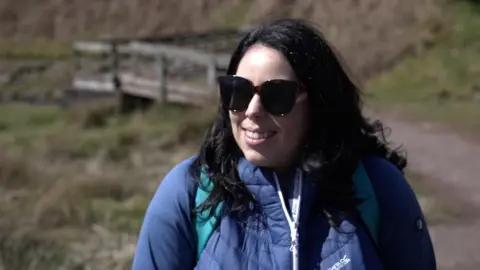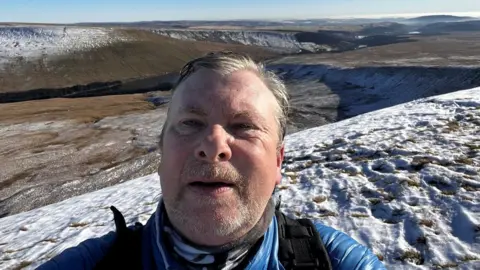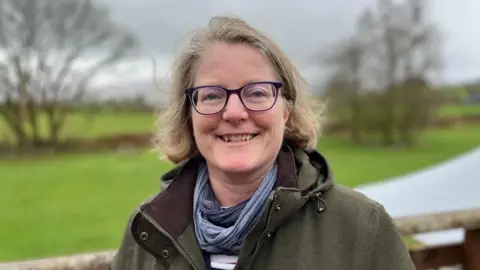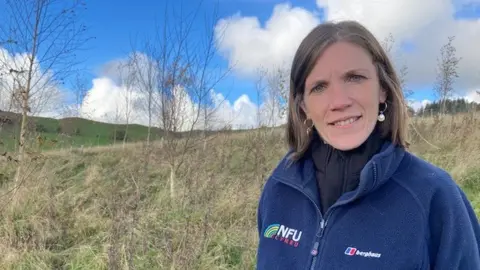Brecon Beacons: Park to use Welsh name Bannau Brycheiniog
Brecon Beacons National Park has announced that it will use its Welsh language name only in future.
The switch - to Bannau Brycheiniog National Park - takes effect on Monday, its 66th anniversary.
Park bosses said the change promotes the area's culture and heritage, but the area MP said the English name could be kept alongside the Welsh.
It is part of a wider overhaul of how the park is managed, to try and address serious environmental challenges.
The Welsh name means "the peaks of Brychan's kingdom" and is pronounced ban-aye bruch-ay-nee-og, with the ch making the same sound as in loch.
Brycheiniog - named after 5th Century King Brychan - was an independent kingdom in the early middle ages, and its borders roughly match those of the national park today.

Resmi Satheesan, a holidaymaker who is originally from India and is currently based in St Albans, Hertfordshire, visits the park often with her family.
"I think it will take us a while to get used to the name, but I wouldn't mind the change," she said.
"More than the name, it's the place [people] are coming for. It's like Mumbai and Bombay - there are still people who say Bombay, but we still know what they are talking about.
"I have spoken multiple languages and travelled a lot, and what's not to love about trying something new or learning something about the locals?"

Laura Howell, from the Gower, Swansea, added: "People will probably keep calling it the Brecon Beacons I imagine, but for those who are Welsh speakers it's a bit of pride and I think it's great that it will be referred to the Welsh way of saying it.
"I think it's a step forward. We live in Wales, so it should be the case."
Mark Jones, from nearby Mountain Ash, Rhondda Cynon Taf, said: "We have bilingual names in Wales and I think it should be a person's choice if they call it by the English name or the Welsh name.
 Mark Jones
Mark Jones"The vast majority of people in Wales are not Welsh speakers as their first language and they will continue to call it the Brecon Beacons.
"I feel it is political and being forced on people slightly. They are making a big point out of it but the reality is people are still going to call it the Brecon beacons."
The Conservative MP for Brecon and Radnorshire, Fay Jones, said she had no prior notice of the name change.
"I think a lot of people were a little taken aback by this decision," she said.
"People who live and work in the national park... want to celebrate Welsh culture. But why not use the Welsh name alongside the English name?"
Ms Jones said she had received several messages of concern from constituents and had been "talking to a local business owner this morning who asked if she'd missed a consultation of a chance to feed in her views".
Responding to Fay Jones, a spokesperson for Bannau Brycheiniog National Park Authority said the park had been engaging in conversation with volunteers, residents, visitors and businesses about its identity and what it means to be a National Park over the past two years.
"This has included a stakeholder reference panel, a citizens assembly and a brand consultation process. We have reclaimed our Welsh name in line with this feedback and adopted a new brand to represent a step change in our ambitions and outlook," the spokesperson said.
"We will be referring to our organisation and our landscape as Bannau Brycheiniog, but we don't expect everyone else to use it, at least not straight away. We want this celebration of our language and heritage to have a positive impact on tourism and local culture."
Plaid Cymru applauded what it called a "positive step in normalising the use of Welsh".
"In reclaiming our original Welsh names, we can reclaim our heritage, which is vital if we want our language to continue to play a role in Wales' future," a spokesperson for the party said.

Bannau Brycheiniog National Park's chief executive, Catherine Mealing-Jones, said: "It just felt the right time to reclaim the old name for the area. [It] reflects our commitment to the Welsh language.
"But we understand people are used to calling the park by the name everyone's used for 66 years, so we don't expect everyone to use it, at least straight away."

It is the second of Wales' national parks to adopt a Welsh-only name, following Eryri (formerly Snowdonia) last year.
The remaining national park in Wales, Pembrokeshire Coast, said it wanted to "reflect all the communities of Pembrokeshire".
It added: "In view of the bilingual nature of these communities... we will continue to use both the official Welsh (Arfordir Penfro) and English versions of the national park's name."
Bannau Brycheiniog covers approximately 520 square miles (1,347 sq km) of south and mid Wales and attracts about four million visitors a year.
Its industrial heritage has won Unesco World Heritage status for the former coal-mining community of Blaenavon.
But recent reports on the state of the natural environment have flagged several concerns.
These include a 30% decline in farmland birds since the 1970s, as well as 67% of waterbodies within the Wye catchment, and 88% of Usk waterbodies failing pollution targets.

A new management plan will attempt to reverse declines in wildlife species across the park by 2030, and reach net zero carbon emissions by 2035, park bosses have said.
It will involve working with partners to plant a million trees, restore 16,000 hectares of damaged peatland, build renewable energy schemes and improve public transport.
"We've got out of balance between people and nature and the climate," Ms Mealing-Jones said.
The plans include creation of wildlife corridors to link habitats and work to achieve bathing water quality standard across all rivers.
Greener transport options will include park and ride pilots between Merthyr Tydfil and Brecon.
A focus on local food will see a push towards more fruit and vegetable farming within the park.

"There are still sheep grazing and cattle in the hills and all the things that are central to what you'd expect from this landscape," Ms Mealing-Jones said.
"But there's more horticulture going on, vineyards, renewable energy sources, we're capturing more carbon into the peatlands and biodiversity is starting to come back."
Stella Owen, NFU Cymru's county advisor, said that, while it was important the national park was put "on a pedestal", local farmers had to have the ability "to run businesses, to be profitable, and to continue in these wonderful, vibrant communities - delivering on the Welsh language, the culture and the social aspect of what we have".
As part of the rebrand, the authority is ditching a picture of a burning beacon from its logo, arguing that the fiery, carbon-emitting symbol no longer fits with its ethos on fighting climate change.
The park has produced a short film to explain the changes it is making, presented by Welsh actor Michael Sheen.
In it, he said he welcomed "the reclamation of the old Welsh name".
